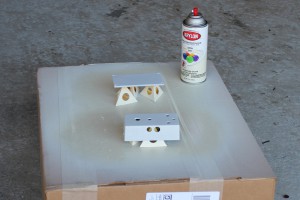Finishing the Enclosure

- Intro to DIY Pedal Building
- Beginner’s Course in Sketchup, Modeling a 125B Guitar Pedal Enclosure
- Drilling a 125B Guitar Effects Pedal Enclosure
- Pedal Enclosure Finishing: Surface Prep, Priming and Painting
- Using GIMP to Create Pedal Artwork
- Printing and Applying Waterslide Decal to Pedal Enclosure
In previous posts, we modeled the enclosure in Sketchup, drilled it, and now we’re ready for paint and artwork. In this video, I talk about options for finishing the enclosure, and choices for art and labels. Then I demonstrate surface prep, priming and painting, in preparation for the waterslide decals.
Some of the resources shown in this video:
- P-touch labeler from Brother
- Adhesive backed window inkjet decal from Papilio, etc
- Papilio inkjet waterslide decal paper
- Moollon etched pedals
- Z-VEX handpainted pedals
- Powder coated enclosures available from Pedal Parts Plus, Mammoth Electronics, etc
- Norton 150-grit multipurpose sandpapers
- Norton synthetic steel wool pads
- Mineral spirits or naptha. Please observe all safety measures- eye protection, gloves, ventilation, etc.
- Painter’s pyramids
- Krylon indoor/outdoor primer white
- Krylon indoor/outdoor paint ivory satin and
- 125b, 1590a, 1590b, 1590bb diecast aluminum enclosures available from Pedal Parts Plus, Mammoth Electronics, etc
September 28, 2012 @ 6:24 pm
If I didn’t know better I would guess you were either a scientist or an engineer, John?
September 28, 2012 @ 7:45 pm
September 28, 2012 @ 6:34 pm
September 28, 2012 @ 7:43 pm
September 28, 2012 @ 8:38 pm
September 28, 2012 @ 10:28 pm
youtube.com/watch?v=g3GxEaj7CCE&feature=related
September 29, 2012 @ 2:20 pm
September 30, 2012 @ 7:58 am
September 30, 2012 @ 8:50 pm
October 1, 2012 @ 3:48 pm
October 10, 2012 @ 2:09 pm
October 11, 2012 @ 6:15 pm
October 15, 2012 @ 9:58 am
October 15, 2012 @ 2:50 pm
Using GIMP to Create Pedal Artwork -
October 15, 2012 @ 10:10 pm
[…] next step in finishing up the pedal that we’ve modeled, drilled and painted previously, is to prepare the artwork and […]
March 29, 2022 @ 12:57 am
Hi John. Thanks for the very instructive videos, with a vibe as soothing as the old Bob Ross painting shows (meant as a huge compliment). I downloaded and installed GIMP, which works well, but the GUI is arranged very differently from yours (I’m on Windows). Any tips on/if you customize your GIMP layout? Thanks, Niel
Waterslide Decals -
December 17, 2012 @ 1:21 pm
[…] and apply a durable clear finish. In previous videos, I showed how to model, drill, and paint the enclosure, and design and prepare the artwork and labels in […]
December 23, 2012 @ 11:48 am
December 30, 2012 @ 10:18 pm
December 31, 2012 @ 8:50 am
January 2, 2013 @ 12:03 pm
January 2, 2013 @ 1:22 pm
March 8, 2013 @ 6:53 pm
March 11, 2013 @ 12:00 pm
it’s the Digitech Death metal pedal and looking to spray it white and blood splat it how would i go about doing that?
March 12, 2013 @ 9:33 am
March 18, 2013 @ 4:48 pm
jOhn,
Just as a thought. Years ago, I used to sell industrial products and paints were considered part of our line. I notice that in the video, you shake your can, end to end. As a salesman, we were taught that this would damage the spraying apparatus and that we should hold the top of the can and swing the bottom side to side. Supposedly, depending on how fast you swing the can, back and forth, you would get enough agitation and not damage the sprayer.
Anyway, just a thought; and, who knows, you might get more paint per can. Great work, as usual. Jim
March 20, 2013 @ 2:37 pm
Hi Jim,
Wow- I’ve never seen anyone shake a can of paint that way! Guess I’ve been doing it wrong all these years 🙂
-John
March 27, 2013 @ 12:37 pm
April 13, 2013 @ 1:50 pm
April 16, 2013 @ 11:13 am
June 9, 2013 @ 8:38 am
Just one question: how long you have to wait between you apply the last spray of primer and you start with the paint? Thanks!
June 11, 2013 @ 8:44 am
June 25, 2013 @ 12:19 pm
July 3, 2013 @ 10:24 pm
July 10, 2013 @ 7:31 am
August 12, 2013 @ 8:04 pm
August 13, 2013 @ 2:42 pm
August 16, 2013 @ 6:00 pm
August 16, 2013 @ 6:01 pm
August 20, 2013 @ 11:58 am
August 29, 2013 @ 5:42 am
October 13, 2013 @ 1:38 pm
January 31, 2014 @ 6:20 pm
and make them look good.
March 29, 2014 @ 7:39 am
motorcycle parts) but the prep, materials advise and painting technique
fully apply to my project. Great video! Thank you!
December 29, 2014 @ 6:52 am
where the clear coat is a little more raised, is to sand back some of the
finish until it is flush, then you can hit it with another even coat of
your clear. I recommend using a straight sanding block and starting with
some 400-600 grit so you don’t remove too much product. Remember, do a few
passes, and check often.
March 9, 2015 @ 5:40 pm
Sketch Me Up! - Planet Z
September 1, 2016 @ 11:12 am
[…] Pedal Enclosure Finishing: Surface Prep, Priming, Painting […]
Intro to DIY Pedal Building - Planet Z
September 1, 2016 @ 11:20 am
[…] Pedal Enclosure Finishing: Surface Prep, Priming and Painting […]
Drilling the Enclosure - Planet Z
September 1, 2016 @ 11:57 am
[…] Pedal Enclosure Finishing: Surface Prep, Priming and Painting […]
DIY Guitar Pedal Building Series – Planet Z
April 27, 2017 @ 9:59 pm
[…] Pedal Enclosure Finishing: Surface Prep, Priming and Painting […]